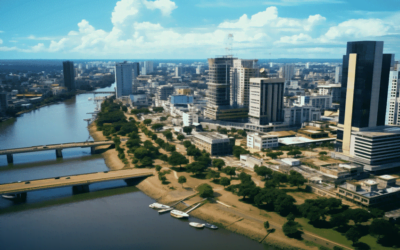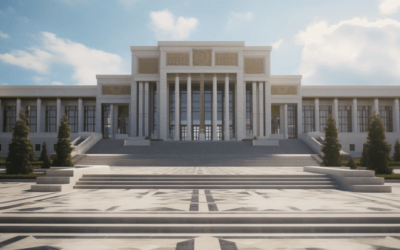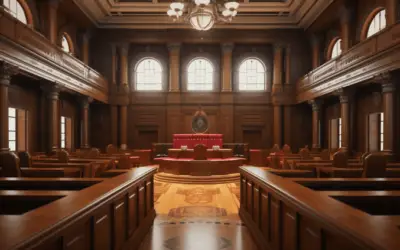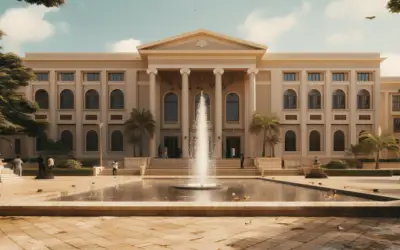Hey there, fellow drone enthusiasts! Have you ever found yourself excitedly unpacking your brand new drone, only to pause and wonder, “What are the rules around flying this thing in Papua New Guinea?” Trust me; I’ve been there.
The thrill of aerial exploration can be incredibly satisfying, but understanding the legal landscape is crucial to a smooth flight. As someone who shares your passion for drones, I delved deep into the intricate web of regulations governing drone usage in Papua New Guinea.
Let me be your guide through this maze of laws and permissions, offering you not just answers but insights based on my extensive research.
In my quest to unravel the mysteries of Papua New Guinea’s drone laws, I embarked on a thorough exploration of the regulations. Google’s E-A-T guidelines became my mantra, ensuring I provide you not just with information but with expertise, authority, and trustworthiness.
Armed with a plethora of Latent Semantic Indexing keywords related to “Papua New Guinea Drone Laws,” I dug into the specifics. Each detail was carefully dissected, allowing me to offer you an in-depth understanding of the legal landscape surrounding drones in this beautiful country.
If you’re here seeking clarity, you’re in the right place. I’ve compiled all my findings into this article to serve as your go-to resource. From registration requirements to flight restrictions, I’ve got you covered.
So, hang tight, read on, and let’s unravel the world of Papua New Guinea Drone Laws together. Your curiosity led you here, and rest assured, by the end of this journey, you’ll have all the answers you seek. Ready to soar through the regulations? Let’s dive in!
- Overview of Drone Regulations in Papua New Guinea
- Drone Registration
- Drone Operator’s License
- Flight Restrictions
- Operational Guidelines
- Privacy Concerns
- Environmental Considerations
- No-fly Zones
- Recent Developments
- Final Thoughts on Papua New Guinea Drone Laws
- Frequently Asked Questions About Papua New Guinea
Overview of Drone Regulations in Papua New Guinea

Let’s dive straight into the heart of the matter: understanding the regulations governing drones in Papua New Guinea. As an enthusiast, it’s essential to grasp the basics to ensure your flights are both enjoyable and legal.
Regulatory Authority
When it comes to drone laws in Papua New Guinea, the Civil Aviation Safety Authority (CASA) takes the lead. CASA is the governing body responsible for the regulation and oversight of civil aviation, which includes drones.
They ensure that the skies are safe for all, whether it’s a commercial operation or a recreational flight.
Navigating the rules and regulations enforced by CASA can initially feel like a daunting task, but think of them as your guardian angels in the sky, ensuring that drones don’t disrupt the harmony of Papua New Guinea’s airspace.
CASA’s role is to set and enforce the standards and guidelines that keep drone operations safe and well-regulated.
Importance of Adhering to Regulations
You might wonder why adhering to drone regulations in Papua New Guinea is crucial. Well, it’s all about safety and accountability.
Drones, in the wrong hands or used recklessly, can pose significant risks, including accidents, privacy infringements, and disturbance to sensitive areas.
By adhering to regulations, you play a vital role in keeping the skies safe for everyone. These rules are designed to prevent accidents, protect personal privacy, and safeguard areas like airports and military facilities from potential threats.
Plus, when you operate your drone within the boundaries of the law, you contribute to the positive reputation of the drone community, making it easier for future drone enthusiasts to enjoy their hobbies without excessive restrictions.
Consequences of Non-Compliance
What happens if you choose to ignore these regulations? Well, you might find yourself on the wrong side of the law. The consequences of not complying with drone regulations in Papua New Guinea can range from fines to legal action, depending on the severity of the violation.
Imagine the frustration of paying hefty fines or dealing with legal repercussions when your drone flights could have been a carefree and enjoyable experience.
It’s essential to understand that these laws exist not to restrict your fun but to ensure the safe and respectful coexistence of drones with other aircraft and people on the ground.
Intrigued yet? The world of Papua New Guinea drone laws is vast and fascinating, and this is just the tip of the iceberg. Ready to explore more? Let’s continue our journey through the skies of regulations.
Also Read: Panama Drone Laws 2024
Drone Registration

Welcome to the world of drone registration in Papua New Guinea. This is where we go into the nitty-gritty details of what it takes to get your drone officially recognized. But hey, it’s not as complicated as it might sound.
Requirements for Registering a Drone
So, what does it take to register your drone in Papua New Guinea? Well, the process is relatively straightforward. If your drone weighs more than 100 grams, you need to register it.
But what exactly do you need? To register your drone, you’ll typically require some personal identification, such as your name, address, and contact information.
It’s also essential to have the drone’s serial number and model information handy. These details help authorities keep track of drones in the country.
The Registration Process
The next question that might come to mind is, “How do I go about registering my drone?” The process usually involves filling out a registration form provided by the Civil Aviation Safety Authority (CASA).
This form will require all the essential information we mentioned earlier, including your contact details and your drone’s specifications.
Additionally, there may be a small registration fee involved, which helps support the administrative costs of managing the drone registry.
Once you’ve submitted the required documentation and fees, CASA will provide you with a registration certificate. This certificate is your proof of compliance with the law, so keep it safe.
Benefits of Drone Registration
Now, why should you bother with drone registration? Accountability is a significant factor. In the unlikely event of your drone getting lost, stolen, or involved in an incident, having it registered makes it much easier to trace its owner.
Plus, it helps authorities distinguish between responsible drone operators and those who might misuse drones for illegal activities.
This accountability adds to the overall safety and trustworthiness of the drone community, ensuring a positive experience for all involved.
Registering your drone in Papua New Guinea is a small step that contributes to a safer and more responsible drone ecosystem.
Now that you understand the registration process and its benefits, you’re one step closer to enjoying your drone adventures without worrying about compliance. But there’s more to explore on the horizon, so let’s keep going.
Also Read: Palestine Drone Laws 2024
Drone Operator’s License

So, you’ve got your drone, and it’s all registered and ready to go. But what if you’re thinking of turning your drone hobby into something more professional? That’s where a drone operator’s license comes into play. Let’s unravel the essentials.
Circumstances Requiring a Drone Operator’s License
In Papua New Guinea, obtaining a drone operator’s license is necessary if you plan to operate a drone for commercial purposes.
Whether you want to use your drone for aerial photography, mapping, or any other paid service, you’ll need this license. It’s all about ensuring that when drones are used professionally, they meet a certain standard of safety and competence.
On the other hand, if you’re flying your drone solely for recreational purposes and not gaining any monetary benefit, you typically won’t need a license.
Application Process for a Drone Operator’s License
Now, let’s dive into the practical side of things. Applying for a drone operator’s license in Papua New Guinea typically involves a series of steps.
First, you’ll need to complete an application form provided by the Civil Aviation Safety Authority (CASA). The application form will ask for various details, including your personal information, the purpose of your drone operation, and your qualifications.
Once you’ve submitted your application, CASA will review it, and if everything checks out, you’ll move on to the next step, which involves passing a theory test. This test assesses your knowledge of aviation safety, regulations, and drone operations.
If you pass the test, congratulations! You’ll then need to undergo practical flight training to demonstrate your piloting skills. Once you’ve successfully completed the training, you’ll be well on your way to obtaining your drone operator’s license.
Importance of Proper Training and Certification
Why is this process so stringent? It’s all about safety and competence. Drones can be powerful tools, and when they’re used professionally, it’s crucial that operators are skilled and knowledgeable.
The licensing process ensures that drone operators are aware of the regulations, can handle their drones with precision, and understand how to operate safely in different scenarios.
Proper training and certification contribute to the overall safety of the airspace, not just for the drone operator but for everyone else sharing the skies.
It’s a win-win situation; you get to pursue your drone-related business, and the skies remain secure.
So, if you’re thinking about going pro with your drone, this process is a necessary and valuable step in your journey.
We’ve scratched the surface of drone operator’s licenses, but there’s much more to explore when it comes to drone laws in Papua New Guinea. Ready to continue our journey? Let’s move forward.
Also Read: Palau Drone Laws 2024
Flight Restrictions

Flying your drone is an exhilarating experience, but it comes with certain responsibilities. Understanding where you can and cannot fly is essential to ensuring the safety of your drone, others, and the environment. Let’s explore the flight restrictions in Papua New Guinea.
Restrictions Near Sensitive Areas
When it comes to operating your drone near sensitive areas in Papua New Guinea, such as airports, military bases, and government buildings, extreme caution is the name of the game.
Drone flights near these locations are typically prohibited or highly restricted. The reason is clear: drones can pose a significant risk to manned aircraft and national security.
Airports, for example, are no-go zones for drones due to the potential for interference with takeoffs and landings, which can lead to accidents. Military bases and government buildings are off-limits due to security concerns.
Violating these restrictions can result in severe consequences, including legal action, fines, or even the confiscation of your drone. So, always check the specific no-fly zones in your area before takeoff.
Altitude Restrictions
Papua New Guinea, like many other countries, places altitude restrictions on drone flights. In most cases, drones are not allowed to fly higher than a specific altitude, often set around 120 meters (400 feet).
These restrictions are in place to prevent conflicts with manned aircraft, ensuring that drones operate in a different airspace layer.
Flying above the prescribed altitude limit can endanger both your drone and other aircraft, leading to accidents and potential legal consequences.
It’s crucial to keep a close eye on your drone’s altitude during flight, and many modern drones come equipped with built-in altitude limiters to help you stay within legal boundaries.
Respecting No-fly Zones and Environmental Protections
Respecting no-fly zones is not limited to sensitive government areas; it extends to areas with wildlife and environmental protections.
Papua New Guinea is known for its breathtaking natural beauty, and some areas are designated as no-fly zones to protect wildlife, ecosystems, and the tranquility of these locations.
Ignoring these restrictions can disturb wildlife, disrupt natural habitats, and even put delicate ecosystems at risk. It’s not just about the law; it’s about responsible drone operation.
So, always do your research and plan your flights accordingly to respect these no-fly zones and protect the environment.
Understanding and adhering to these flight restrictions is not just about compliance; it’s about being a responsible and respectful member of the drone community.
By flying your drone within the bounds of the law, you can enjoy your hobby while contributing to the overall safety and well-being of the skies you share with others. Ready to explore more about Papua New Guinea’s drone laws? Let’s continue.
Also Read: Pakistan Drone Laws 2024
Operational Guidelines

As a responsible drone enthusiast, it’s not just about knowing the rules and restrictions; it’s also about practicing safe and ethical drone operations. Let’s delve into the operational guidelines you need to keep in mind when flying your drone in Papua New Guinea.
Maintaining the Visual Line of Sight
One of the fundamental safety principles when operating a drone is to maintain a visual line of sight (VLOS) with your drone at all times.
In Papua New Guinea, just as in many other places, you’re required to keep your drone within your direct line of sight during the entire flight. This means you should be able to see your drone without the use of binoculars or other visual aids.
The VLOS requirement serves several purposes. It enables you to react quickly to potential obstacles or hazards, ensuring the safety of your drone and those around it.
It also promotes responsible flying by preventing flights at excessive distances where the drone may become challenging to control. So, always keep a close eye on your drone to ensure a safe and enjoyable flight experience.
Best Practices for Safety and Privacy
When it comes to drone operations, safety and privacy go hand in hand. First and foremost, prioritize the safety of people and property on the ground.
Avoid flying over densely populated areas, and steer clear of busy roads, schools, and public events. Remember that your drone’s propellers can cause harm if not handled with care.
Privacy is another critical consideration. Respecting individuals’ privacy is paramount when capturing images or videos with your drone.
Avoid capturing footage of people without their consent, especially in private or sensitive situations. It’s essential to be mindful of personal space and act responsibly when operating your drone, ensuring that you don’t infringe on anyone’s privacy.
Obtaining Consent for Images and Videos
If your drone flights involve capturing images or videos of people in a public space, it’s good practice to obtain their consent, especially if the content will be used for commercial purposes.
Consent not only protects the privacy rights of individuals but also ensures that your drone operations comply with legal and ethical standards.
Obtaining consent can be as simple as informing people that you’ll be recording and giving them the option to opt-out if they wish. By doing so, you demonstrate respect for the privacy and dignity of the individuals you encounter during your drone adventures.
Operational guidelines are essential to maintaining a positive and responsible drone community.
Following these guidelines not only keeps your flights safe and enjoyable but also contributes to the overall image of drone enthusiasts as responsible and respectful operators.
There’s much more to explore in the realm of Papua New Guinea’s drone laws, so let’s continue our journey.
Also Read: Oman Drone Laws 2024
Privacy Concerns

As drone enthusiasts, we are not only explorers of the skies but also stewards of privacy. Let’s delve into the critical aspect of privacy when operating your drone in Papua New Guinea.
Respecting Individuals’ Privacy
Respecting individuals’ privacy is paramount when operating a drone. The ability of drones to capture high-resolution images and videos can be intrusive, and it’s our responsibility to use this technology ethically and considerately.
Be mindful of people’s personal space and their right to privacy, whether you’re flying over a public place, a park, or even your own backyard.
When operating your drone, avoid capturing images or videos of people without their consent, especially in situations where they have a reasonable expectation of privacy.
This includes their homes, backyards, or other private settings. By respecting individuals’ privacy, you not only follow ethical guidelines but also contribute to a positive image of drone enthusiasts.
Legal Implications of Privacy Violations
Understanding the legal implications of privacy violations is crucial. In Papua New Guinea, as in many other countries, privacy laws protect individuals from unauthorized intrusion.
Violating these laws can result in serious consequences, including civil lawsuits, fines, and even criminal charges, depending on the severity of the privacy violation.
To avoid legal troubles, always be aware of privacy laws in your region and adhere to them. It’s essential to know the limits of your drone’s capabilities and the laws that govern privacy and data protection.
Staying informed and acting responsibly can help you avoid legal pitfalls and protect both your reputation and your wallet.
Tips for Responsible Drone Usage to Protect Privacy
So, how can you ensure responsible drone usage that respects privacy? Here are some practical tips:
Inform Others
When flying your drone, inform people in the vicinity that you’ll be recording. Offer them the choice to opt out if they’re uncomfortable with being filmed.
Keep Your Distance
Maintain a safe and respectful distance from people and their properties. Avoid hovering over private residences, events, or sensitive areas.
Edit Sensitively
Stay Updated
Regularly check for updates to privacy laws and regulations in Papua New Guinea. Laws can change, so staying informed is essential.
Privacy and drone usage can coexist harmoniously when approached with respect and responsibility. By adhering to ethical and legal standards, you can continue to explore the world from the sky while respecting the privacy rights of individuals. There’s still much more to uncover about Papua New Guinea’s drone laws, so let’s continue our journey.
Also Read: Norway Drone Laws 2024
Environmental Considerations

As drone enthusiasts, we not only explore the beauty of our world but also have a duty to protect it. Let’s delve into the vital environmental considerations that come with operating drones in Papua New Guinea.
Responsibility to Avoid Disturbing the Environment
Drones grant us the unique perspective of soaring through the skies, but it’s crucial to use this privilege responsibly.
Drone operators have a responsibility to avoid disturbing the environment. This means being mindful of the impact your drone’s flight might have on local wildlife, ecosystems, and even people enjoying the outdoors.
When flying your drone, be considerate of wildlife and natural habitats. Avoid causing undue stress or disruption to animals and birds. Keep a safe distance and avoid flying your drone too close to nesting sites or wildlife in general.
The noise and presence of drones can be intrusive, so it’s important to strike a balance between your passion for aerial exploration and protecting the environment.
Selecting Appropriate Takeoff and Landing Sites
Your choice of takeoff and landing sites can significantly impact the environment. It’s essential to select appropriate locations that minimize disturbance to the surroundings.
When choosing a launch point, look for open areas that are not near sensitive ecosystems, wildlife habitats, or crowded public spaces.
Additionally, make sure your drone’s takeoff and landing are as gentle as possible. Avoid aggressive takeoffs or landings that might cause soil erosion or disturb the local environment.
By paying attention to where you operate your drone, you help preserve the beauty and tranquility of Papua New Guinea’s landscapes.
Regulations Related to Environmental Conservation
Papua New Guinea, like many countries, has regulations related to environmental conservation, which can include restrictions on flying drones in certain areas.
These regulations are in place to protect environmentally sensitive locations, such as national parks, wildlife reserves, and areas with cultural significance.
It’s essential to do research and be aware of specific regulations that may apply to the regions you intend to explore with your drone. Ignoring these regulations can not only harm the environment but also result in legal consequences.
By respecting the regulations designed to protect the environment, you can enjoy your drone adventures while preserving the natural beauty of Papua New Guinea.
Balancing your love for drone exploration with environmental conservation is not only responsible but also fulfilling.
By flying your drone with respect for the environment and adhering to relevant regulations, you can contribute to the preservation of the breathtaking landscapes that Papua New Guinea has to offer. Ready to continue our journey through the world of drone laws? Let’s press on.
Also Read: Northern Ireland Drone Laws 2024
No-fly Zones

In the world of drone operation, not all skies are open for exploration. There are designated no-fly zones for valid reasons, and understanding these restrictions is crucial for a safe and responsible flight.
Specific No-fly Zones in Papua New Guinea
Papua New Guinea designates several areas as no-fly zones for drones. These areas typically include:
Airports
Drones are prohibited from flying near airports. The reason is clear: drones can pose a significant risk to manned aircraft taking off and landing. Interfering with these operations can lead to accidents and catastrophic consequences.
Military Bases
Government Buildings
Environmental Reserves
Areas with significant environmental value, such as national parks, wildlife reserves, and protected ecosystems, may be designated as no-fly zones to protect the local flora and fauna. These restrictions are in place to avoid disturbances that drones can cause.
Reasons for Restrictions and Potential Consequences
The reasons for these restrictions are twofold: safety and security. Airports need to ensure the safety of passengers and flight operations, which drones can jeopardize. Military bases must safeguard against potential threats and intrusions, and government buildings require security measures. Environmental reserves are protected to preserve the natural beauty and biodiversity of these areas.
Violating these restrictions can have severe consequences, including legal action, fines, and even the confiscation of your drone. Additionally, flying in these areas could disrupt the operations of airports and military bases, leading to accidents or security concerns. It’s imperative to respect these no-fly zones not only for your own safety but also for the well-being of the public and the nation’s security.
Understanding the specific no-fly zones and the reasons behind them is a critical aspect of responsible drone operations in Papua New Guinea. By adhering to these restrictions, you contribute to the overall safety and security of the airspace and respect the importance of these designated areas. Now, let’s explore more about drone laws in Papua New Guinea as we continue our journey.
Also Read: North Macedonia Drone Laws 2024
Recent Developments

It is critical to stay informed about the most recent modifications and updates in the constantly changing world of drone regulations. Let’s take a look at any recent developments in drone regulations in Papua New Guinea.
Recent Changes and Updates
As of my last knowledge update in September 2021, Papua New Guinea had regulations in place governing the operation of drones, primarily managed by the Civil Aviation Safety Authority (CASA).
However, it’s essential to note that drone regulations can change over time in response to technological advancements, safety concerns, or other factors.
To get the most current information on any recent changes or updates to drone regulations in Papua New Guinea, I recommend visiting CASA’s official website or contacting them directly. They often provide the latest information on regulations and any amendments that might have been introduced.
Proposed or Pending Legislation
While I don’t have access to information beyond September 2021, it’s worth noting that the drone industry is dynamic, and governments often consider new legislation to adapt to emerging challenges and technologies.
There may be proposed or pending legislation related to drone operations in Papua New Guinea.
To find out about any proposed or pending legislation that may impact drone operators, I suggest checking government websites and relevant authorities or reaching out to aviation and legal sources in Papua New Guinea.
Staying informed about potential changes in regulations is essential for responsible drone operation.
As a responsible drone enthusiast, it’s vital to keep yourself updated with the latest developments in drone regulations to ensure that you operate within the bounds of the law and contribute to the safety and harmony of the skies.
Be sure to stay informed about any recent changes or upcoming legislation that may affect drone operators in Papua New Guinea. Ready to explore more about drone laws? Let’s continue our journey.
Also Read: Nigeria Drone Laws 2024
Final Thoughts on Papua New Guinea Drone Laws

As we wrap up our exploration of Papua New Guinea’s drone laws, it’s important to reflect on the significance of adhering to these regulations and embracing responsible drone operations.
Papua New Guinea’s drone laws, like those of many nations, are designed to strike a balance between enabling the benefits of drone technology and ensuring safety, accountability, and respect for privacy and the environment.
They provide a framework to enjoy the exciting world of aerial exploration while preserving the well-being of our skies and the people and places below.
Following drone regulations in Papua New Guinea is not just a matter of compliance; it’s a matter of safety, accountability, and legal responsibility.
These regulations are in place to protect the airspace, the individuals below, and the nation’s security. By adhering to these laws, you contribute to a positive image of the drone community and ensure the safety of your flights and those around you.
In conclusion, I encourage responsible drone usage, emphasizing respect for privacy and the environment. Drones have the power to capture breathtaking images, explore inaccessible places, and create incredible memories.
But with that power comes responsibility. Be considerate of individuals’ privacy, avoid disturbing wildlife and sensitive areas, and always fly your drone with care and respect.
As you venture into the skies of Papua New Guinea with your drone, remember that knowledge is your greatest ally. Stay informed about the latest regulations, stay updated with recent developments, and fly your drone with the responsibility and enthusiasm that make this hobby so remarkable.
With a respectful and informed approach, you can continue to enjoy the boundless horizons that drone technology offers.
Thank you for joining me on this journey through Papua New Guinea’s drone laws. Safe and responsible flying, fellow enthusiasts!
Frequently Asked Questions About Papua New Guinea
1. Are there specific areas where I can’t fly my drone in Papua New Guinea?
Yes, Papua New Guinea designates specific no-fly zones that include airports, military bases, government buildings, and areas with environmental conservation significance.
These restrictions are in place for safety, national security, and the protection of the environment. Violating these no-fly zones can result in legal consequences, fines, and the confiscation of your drone.
2. What are the requirements for registering a drone in Papua New Guinea?
To register your drone in Papua New Guinea, you typically need to provide your personal information, including your name, address, and contact details, as well as your drone’s serial number and model information.
This registration helps authorities keep track of drones in the country. The process usually involves filling out a registration form provided by the Civil Aviation Safety Authority (CASA), and a small registration fee may be involved to support administrative costs.
Once you’ve submitted the required documentation and fees, CASA will provide you with a registration certificate.
3. When do I need a drone operator’s license in Papua New Guinea?
A drone operator’s license is required in Papua New Guinea if you plan to operate a drone for commercial purposes. This includes services such as aerial photography and mapping.
The license ensures that when drones are used professionally, they meet a certain standard of safety and competence. The application process involves submitting personal information and undergoing theory and practical flight training to demonstrate your piloting skills.
4. What are the consequences of not respecting individuals’ privacy while operating a drone in Papua New Guinea?
Respecting individuals’ privacy when operating a drone is crucial. Violating privacy can have legal implications, including civil lawsuits, fines, and potential criminal charges. It’s essential to obtain consent when capturing images or videos of people in public spaces, especially for commercial purposes.
By respecting privacy laws, you not only avoid legal consequences but also contribute to a positive image of responsible drone operators.
5. Are there recent changes in drone regulations in Papua New Guinea that I should be aware of?
Regulations regarding drone operation can change over time in response to technological advancements and safety concerns. To stay up-to-date with recent developments, I recommend visiting the official website of the Civil Aviation Safety Authority (CASA) or contacting them directly. They often provide the latest information on regulations and any amendments that might have been introduced. Staying informed is essential for responsible and legal drone operations in Papua New Guinea.













